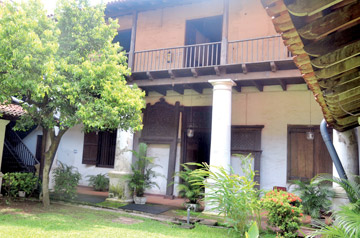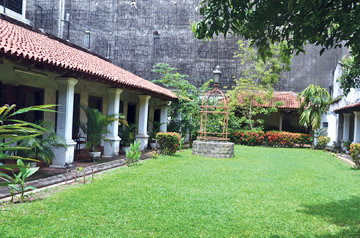The Dutch Museum - A journey into the past
By Sureshini Pilapitiya
 The English doctor Ives who visited Colombo in 1757 wrote: "The
streets are very wide with a row of beautiful trees. There is a very
smooth and regular pavement on each side between them and the houses.
The whole is so elegantly disposed that we could not help admiring the
wisdom and the genius of the Dutch." The English doctor Ives who visited Colombo in 1757 wrote: "The
streets are very wide with a row of beautiful trees. There is a very
smooth and regular pavement on each side between them and the houses.
The whole is so elegantly disposed that we could not help admiring the
wisdom and the genius of the Dutch."
But nowadays, the streets of Colombo have quite a different
atmosphere altogether, and the Dutch splendour which he mentioned has
faded but still, there are remains of its glory, and there is a
significant building which represents that glory.
The Dutch Museum has been established in Prince Street in Pettah,
amidst the busy, noisy and dusty streets and shops, which makes one
imagine why such a beautiful and a magnificent building could be located
in such an area.
But this particular area in Pettah is considered historical, because
the residence of colonel Henry Steel Olcott and the former kachcheri is
also located here.
But once you enteryou certainly get a peaceful and relaxed feel as if
in a different world taking you along a journey of the past, away from
the hustle and bustle of the noisy streets of Pettah.
The museum generates a special significance because the history of
the building goes back to 1692- 1696 AD, as the official residence of
the Dutch Governor, Thomas Van Ree, and also becoming the oldest two
storeyed building presently in Colombo representing Dutch Architectural
features.
The building consists of traditional Dutch Architecture, furniture,
coins, bobbin lace knitting,(beeralu), typography, symbols of the
protestant religion and a good number of antiques which tells us of the
once domineering Dutch history.
 The Dutch ruled the maritime provinces of Sri Lanka during the period
of 1658- 1696 AD. The museum also has a lovely court yard with a well
which is almost as good as new, wooden upstair, floor paved with bricks,
large door, high and broad walls with door frames, large verandahs and
roof covered with semi circular tiles having deep slopes at either
sides. The Dutch ruled the maritime provinces of Sri Lanka during the period
of 1658- 1696 AD. The museum also has a lovely court yard with a well
which is almost as good as new, wooden upstair, floor paved with bricks,
large door, high and broad walls with door frames, large verandahs and
roof covered with semi circular tiles having deep slopes at either
sides.
This valuable building was sold to the VOC Company (Dutch Eastern
Indian Company) by the Governor, Thomas Vanree after his regime was over
and and the building was maintained as an orphanage and a place of
worship until the termination of the Dutch period.
But after the British took over, the building was used as an army
hospital, an armoury, a police training cent re, and finally as a part
of Pettah post office and a telecommunication centre. The museum was
established by the department of National Museums in 1982.
Iresh Alawaththa, officer in charge of the Dutch Museum told the
Sunday Observer that though this is located in a crowded area, foreign
and local tourists and University students come in search of information
and explore the building, and tourists visit the place since it is
mentioned in the guide book.
This belongs to the Department of Archeology and it is maintained
under the Department of National Museums.
The building was conserved in 1982, and they have plans of re-doing
the conservations again. Recently the ancient roof was renovated. The
whole area consists of 50-60 perches, and some of the items have been
brought from the Colombo museum, while the other antiques have been
brought from different places.
He said among the most significant items of the museum are Dutch
tombstones, an ancient bell, a gun-loader belonging to the Kandyan Era,
weapons belonging to the Kandyan era are there, including furniture as
well. Some Dutch coins have been brought in from the Colombo museum.
Historical events such as paying a visit to the Kandyan king by Joris
Van Spill Bergen, who was the first Dutch national who arrived in Sri
Lanka and paying a visit to the Kandyan king by Jerad Halfert, who took
the lead to save Colombo Fort from the Portuguese are attractively
displayed in the ground floor at this museum. Alawaththa says that there
is a car park for the museum as well, though vehicles are parked
everywhere.
A good knowledge can be gained by getting information on maritime
activities of the the Dutch and their Eastern sea routes, the ships
which they used during the 17th and the 18th centuries and their eastern
commodities.
 The throne which is in the Colombo museum was actually gifted by the
Dutch to the Kandyan king, as a token of respect. The photograph of the
throne, which was gifted to the Kandyan king, the local Dutch coins used
for trade activities in the hill country and the relationship between
the Dutch and the Kandyan kingdom are well displayed. The throne which is in the Colombo museum was actually gifted by the
Dutch to the Kandyan king, as a token of respect. The photograph of the
throne, which was gifted to the Kandyan king, the local Dutch coins used
for trade activities in the hill country and the relationship between
the Dutch and the Kandyan kingdom are well displayed.
Apart from those, there are several attractive items such as domestic
appliances, and artistic items such as ornaments made of silver and
beads, Dutch costumes and valuable furniture kitchen equipment, tobacco
boxes with beautiful carvings and ceramics with attractive designs can
be seen too.
One of the most attractive items was a cake mould which is certainly
unbelievable that they had such items during that era, a beautiful
jewelery box and the Dutch couple who were dressed in the costumes of
that era was also interesting. All this shows the creative art and
culture which was there in the Kandyan kingdom during the 17th and 18th
centuries.
Duits (doithu in sinhala) were the coins commonly used in the Dutch
period. There were stone plaques which had engravings which were created
to promote their religion and an ancient Dutch ebony cot, a large jack
wood Dutch bed. This wooden furniture are located upstairs, and there
are many more such as writing tables, arm chairs, cabinets, chairs
including carved chairs, corner chairs and a burgomaster chair which are
enriched with artistic qualities and shows their vivid imagination and
creativity in making beautiful objects which certainly is a glee to the
eye.
The huge pillars which holds the magnificent building have been there
ever since the it was made, continues to stand still and strong
throughout the centuries.
Duplicates of Dutch registers, a copy of the first page of the first
published sinhala book, copies of correspondence between Sinhala kings
and the Dutch governors, copies of the agreement to concede the maritime
provinces to the Britishers by the Dutch are historically important.
One of their main attractions are their educational documents, which
represents their educational system of that era. There was a display of
spices which they used in the Dutch era, such as Cinnamon. One of the
main purposes why the Dutch invaded Sri Lanka was the search for
Cinnamon.
And two of their most famous specialties can be named such as ''Lamprais''
and Breudher. The garden is well kept , and the well, which dates back
to the time the building was also an eye catcher.
 And it is amazing to see that it still has water in it! The building
certainly adds historical value to the whole area. And it is amazing to see that it still has water in it! The building
certainly adds historical value to the whole area.
The museum is open to visitors from 9am to 5pm, on weekdays, except
Sundays, Mondays and public holidays.
The building certainly looks like a place in paradise compared with
the filthy surroundings and proper renovation should be done to preserve
this valuable building for future generations.
The entrance fee is Rs.25 for local tourists and Rs. 500 for
foreigners. Further inquiries can be made from the curator and
demonstrator there.
This lovely mansion of a Dutch Governor is certainly a place to visit
for those who likes to travel, explore and have a bit of adventure which
is worth taking some time off and doing a stroll. |

